How to choose a reverse osmosis filter: rating of the best manufacturers and their products
Almost every one of us has thought about the quality of the water we consume.In practice, buying bottled water every day turns out to be very expensive, and tap water without additional purification is completely unsuitable for this purpose. Do you agree?
It turns out that this problem is quite easy to deal with. By using a reverse osmosis filter from a trusted manufacturer, you can be confident in the quality of the water you consume. With the huge range of reverse osmosis systems on the market, making the right choice is not easy, but we will help you find the right solution.
In this article we will talk about the principles of operation of reverse osmosis filters, the criteria for their selection, provide an overview of models from the best manufacturers, and also give recommendations for the operation of filters. The material is accompanied by thematic photos and videos.
The content of the article:
Direct and reverse osmosis
Natural osmosis is a phenomenon that underlies the metabolic process occurring in living organisms. It ensures a balanced state of salt and mineral metabolism.
Living cells are washed by blood and lymph; from these fluids, nutrients enter through the shell, which is a semi-permeable membrane, and waste products are removed back.
The semipermeable membrane has selective permeability.Having an electric charge on its outer surface, it repels minerals dissolved in water, the molecules of which have broken down into ions as a result of hydrolysis.
These mineral substances carry special transport molecules into the middle of the cell through separate channels located in the cell membrane.
To simulate the process in laboratory conditions, take a vessel and divide it into 2 parts using a semi-permeable membrane. On the right side of the partition, a highly concentrated aqueous solution of a mineral substance is poured, on the other - everything is the same, but in a much lower concentration.
Striving for balance, water from the left side moves to the right. The process continues until the concentration of solutions on both sides becomes the same.
Once an equal level of concentration is achieved, the height of the liquid columns located on different sides will be unequal. The difference in height will be directly proportional to the force forcing water through the membrane, called "osmotic pressure".

Reverse osmosis - a phenomenon directly opposite to natural osmosis. Still in the same vessel, under the influence of external pressure on a solution of high concentration, the water changes direction. The applied pressure simply forces it through the membrane, freeing it from substances dissolved in it.
The concentration of the solution, which was already higher initially, increases further, and the lower one continues to decrease. Only water passes through the membrane, as before, but in a different direction.
We recommend an article on the topic: Reverse osmosis: harm and benefits of membrane purification of tap water.
The principle of operation of such a filter
The principle of water purification using reverse osmosis is based on the fact that a concentrated aqueous solution is supplied under pressure into a container separated by a semi-permeable membrane. Water filtered through the membrane enters the second part of the container; mineral substances remain outside it and then go down the drain.
The filters consist of modules that are easily replaced during operation. Each of them has a certain service life.

The system design includes several filter cartridges with activated carbon and porous polypropylene inside. With their help, water is freed from solid particles and organic impurities. At the first stage, when passing through a polypropylene filter, water is freed from particles with a minimum size of 0.5 microns.
The second filter is a carbon filter, which removes organic and chemical impurities from the water, including petroleum products, pesticides, heavy metals and other substances. The last filter in front of the reverse osmosis membrane retains microscopic mechanical impurities, their size does not exceed 1 micron.
The main element in the system is a membrane, into which water flows under pressure after rough pre-treatment. Its pores, 0.0001 microns in size, do not let anything through except water molecules. When it passes through the post-filter, the final purification and stabilization of the water occurs.
Here the flow is divided into two parts: crystal clear water and a concentrated solution, which is discharged into the sewer system.Clean water that does not require boiling flows into a storage tank, and then through a separate tap to the consumer.
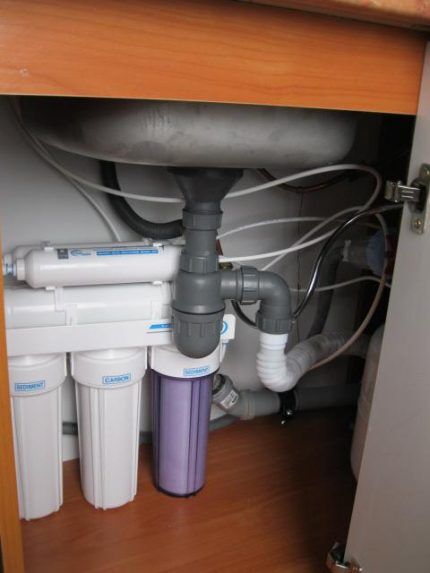
The system is designed in such a way that as purified water is consumed, its reserves are replenished automatically. From the inside, the tank consists of 2 chambers, with a silicone membrane serving as a partition between them. Water enters the upper compartment, and compressed air is located in the lower compartment.
As the volume of water decreases, the membrane expands, maintaining pressure until the water is completely drained. The air pressure can be adjusted via a nipple installed on the side of the lower chamber.
For individual selection of drinking water, a special tap is installed into the countertop or kitchen sink, independent of the flow used for other purposes.
Some manufacturers provide their products with additional functionality:
- mineralizer, introducing useful microelements into the water that the membrane did not miss;
- ultraviolet lamp, killing harmful microbes;
- structurer, ridding water of “negative” information.
Water consumption during such cleaning cannot be called economical - when receiving 1 liter of potable water, 3 liters of dirty water go down the drain. For the system to operate, pressure is required in the range of 2-6 bar, so sometimes it needs to be increased using a pump or decreased using a reducer.
Criteria for selecting a filter system
Price reverse osmosis filters quite high. Their choice must be approached responsibly, having previously assessed your financial capabilities both at the moment and in the future, taking into account the need to periodically replace modules.
You should also understand that most filters purify water very slowly. The speed of water passage depends from pressure in the water supply, concentrations of various impurities in water, membrane permeability. You should not count on their greater productivity.
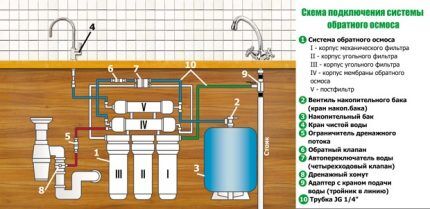
So how do you choose a reverse osmosis filter?
An assessment based on the following criteria will help you make the best choice:
- Number of cleaning stages. There can be from 3 to 9.
- The presence of additional functionality.
- Manufacturer's credibility.
- Material and number of prefilter stages. Plastic should be odorless.It’s easy to check its presence, you just need to spin the flask.
- Reliability of seals on flasks and connecting elements. The first should be double, and the best compounds are products from the companies JohnGuest and Organic.
- The material from which the storage tank and mounting plate are made.
- Membrane performance.
- Availability of a pump.
- Tank capacity.
- Resource of membrane and cartridges.
- Type of flask. Block-module cartridges are more expensive than filler cartridges, but they are easier to replace. A flask installed in a glass internally is considered to be of higher quality.
- Compliance of the dimensions of the structure with the availability of free space under the sink.
The design of the crane is of considerable importance. There may be 1 valve for purified water or 2 if a mineralizer is included in the system.
The color of the flask serves as an indicator of quality. Its surface should be white or matte without streaks or impurities. A completely transparent flask has very thin walls, and under the influence of high pressure they can simply break.
Often, unscrupulous manufacturers use such a trick as increasing the weight of the flask, thereby masking the flaws of the material. Such products give off an unpleasant odor. A good flask should be neither too heavy nor too light.
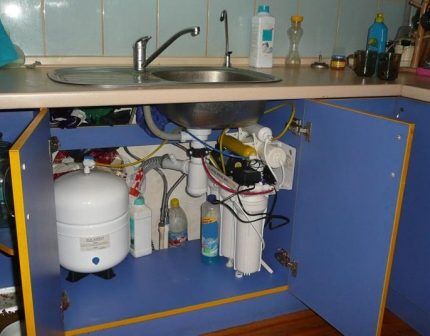
Housings made from high-quality raw materials can withstand high pressure well. They have smooth inner walls without the slightest hint of pores. Bacteria and solid particles will not be able to penetrate such a surface. When recycled materials are used, microcracks are observed on the surface of the body, sometimes leading to splits.
Manufacturers use plastic or metal to make the tank. The latter has a longer service life, while the former does not rust.
When choosing, you need to proceed from the operating conditions of the cleaning system. For an apartment or house where people live permanently, a plastic model is suitable, but for a summer house it is better to choose a metal tank. The volume of tanks of different models ranges from 4-12 liters.
Membranes for reverse osmosis filters are produced by many manufacturers. The cheapest products are made in China. They are characterized by a small resource and below average quality.
The most popular membranes include Filmtec, Osmonics, Pentair, manufactured under US license, and TFC from a manufacturer in South Korea. At normal pressure in the system, they last 2.5-5 years.
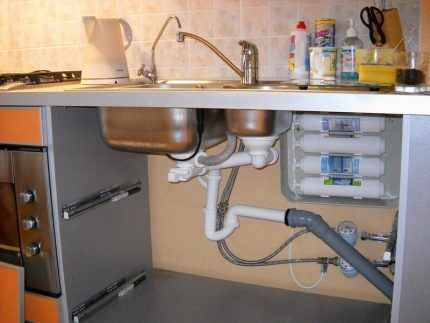
So, the following basic characteristics are especially important when choosing: the number of stages, the presence of additional cartridges and their service life, the presence of a pump, design dimensions, productivity.
Rating of the best water purification systems
The range of household reverse osmosis filters is represented by a huge number of offers from different brands. Not all of them are worthy of attention. When choosing a filter for washing, you should pay attention to the manufacturer, user reviews, and how long it has been on the domestic market.
In order not to doubt the quality of the purchased system, you can check your choice with the rating of popular filters from professionals involved in the installation and maintenance of reverse osmosis water systems over a long period. The most popular brands include: Atoll, Leader Standart, Aquaphor, Novaya Voda, Barrier, Geyser.
Place #1. Water filter from Atoll
This is a compact model with a 5-stage cleaning system. It is possible to install the tank in a separate cabinet if there is not enough free space under the sink.
When replacing cartridges, you do not need to disconnect the tap, tank and the system itself from the sewer system. The performance of the household model membrane is sufficient for the needs of a family of 3-4 people.
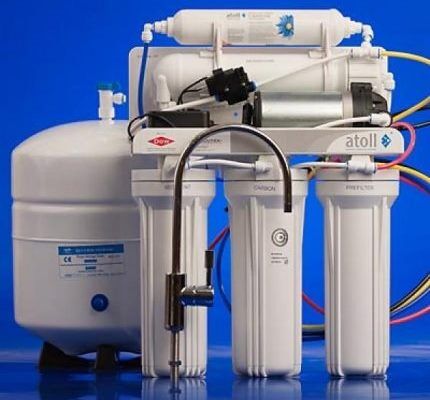
The membrane is made of high quality polymer material and is produced in the USA. The design of the system is simple and affordable to maintain.
The filter is protected from leaks by its excellent build quality and the fact that it uses John Guest fittings, the reliability of which has long been recognized in the world. The manufacturer equips each model with a designer faucet.
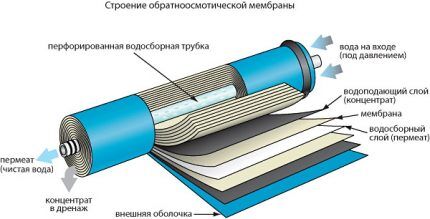
For the Atoll reverse osmosis system to operate effectively, the pressure in the water supply must be maintained at a level of 3 to 8 atm. If the upper limit is exceeded, a malfunction may occur; to prevent such cases, a pressure reducing valve is required. Pressure below 3 atm also leads to failures if a design without a pump is installed.
Place #2. Filters marked Leader Standard
Leader Standard drinking systems are of high quality. They are produced in Poland and Korea.
Some filter models include a bioceramic cartridge, inside of which are hermetically sealed clay balls with the addition of the mineral tourmaline.Their value lies in the fact that they produce long infrared waves that change the structure of water and give it healing properties.
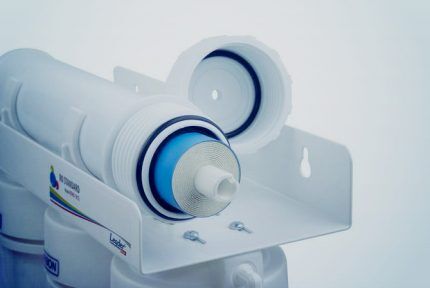
The water that passes through these reverse osmosis filters is purified by 97-99%. The manufacturer provides a guarantee for flawless operation for 36 months.
Place #3. Compact filter Aquaphor Morion
A relatively inexpensive and ergonomic filter operating on the principle of reverse osmosis was created by the Aquaphor company.
The device is equipped with a storage tank with a capacity of 5 liters, built into the housing, 3 replaceable modules, a module with a membrane, a set of tubes for connection, taps - inlet and for purified water, a coupling for connecting the system to the sewer.
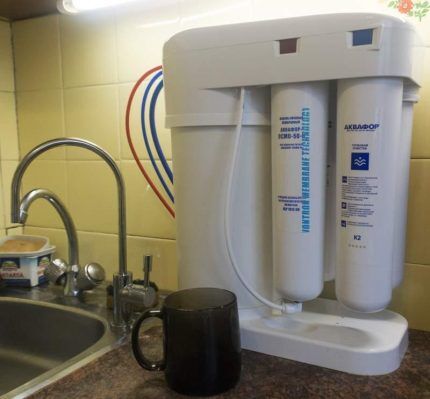
The first of the modules with a polypropylene filter performs mechanical pre-cleaning. It needs to be replaced every 3 months. Deep purification is performed by the second module containing sorbents in the form of fibers and granules. With its help, heavy metals, organic matter, and active chlorine are removed from water. Replacement frequency is every six months.
The module with a membrane is designed for ultra-deep cleaning. Passing through it, water is freed from bacteria, viruses, harmful impurities, nitrites, nitrates, and salts that give it hardness.
This module is changed every one and a half to two years. Final purification and mineralization of water occurs in the fourth module, which must be replaced annually.
Place #4. Installation "New Water"
In addition to the reverse osmosis filter, the system is equipped with a mineralizer and a bioceramic activator. New modifications of filters from the Novaya Voda company are called smart systems. They are distinguished by increased productivity, an unusual design of the faucet, which has an LED indicator that reacts to a hand brought to the body.
One of the company's new developments is a full automatic, high-tech 6-speed system. It operates electronically and is equipped with a display, electric pump, electronic pressure sensors and valves. If the membrane is dirty, the electronic controller sets a special mode and it is washed.
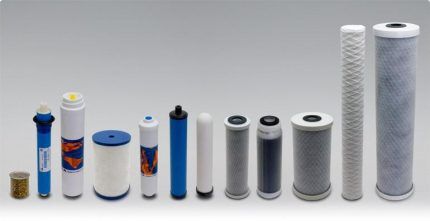
The filter design includes a post-filter mineralizer with silicon-shungite filler, which enriches the water with potassium, calcium, magnesium, and sodium ions, thereby increasing its biological value. The storage metal tank holds 12 liters of water. Membrane capacity is 185 liters per 24 hours.
Place #5. Reverse osmosis system "Barrier Osmo 100"
The capacity of this system is 228 liters per day. At operating pressure from 3 to 7 atm, water goes through 5 stages of purification:
- "BARRIER PROFI Mechanics 5 microns" retains solid particles whose size exceeds 5 microns. The inside of the filter is food-grade polypropylene.
- "BARRIER PROFI Sorption" removes organic matter, chlorine, and organochlorine compounds. The filler is activated coconut charcoal in granules.
- “BARRIER PROFI Mechanics 1 micron” is the last preliminary stage of cleaning before the membrane, when fine suspensions are screened out.
- “BARRIER PROFI Osmo” is the main cleaning stage. The membrane is made of ultra-thin composite polyamide.
- “BARRIER PROFI Postfilter”, where carbon enriched with silver is placed. Additionally purifies and enriches water after the storage tank.
The membrane is replaced every 1.5 years, and mechanical cleaning modules are replaced once a year. The capacity of the plastic filter tank Barrier Osmo 100 is 8 l.
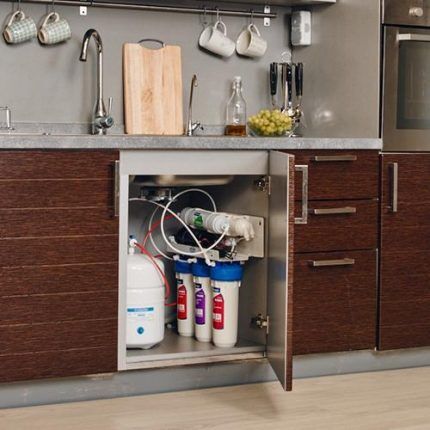
The filter is produced by a Russian company, so its cost is lower than its foreign analogues. Consumers do not complain about quality. The housing part of the filters from the Barrier company is very strong. All filter elements are of decent quality.
Place #6. Sink filter “Geyser Prestige”
Three stages of purification allow you to retain heavy metals, chloride salts, bacteria, and viruses. Cartridge productivity is 0.13 liters per minute. A special feature of the Geyser company’s development is a sorption device, which can only be purchased directly from the manufacturer.
The throughput of the membrane is 0.0001 microns, which allows you to purify water at the ionic level. They change it once every 1.5 years. The pressure required for the system to operate is not lower than 3 atm. The name “Geyser Prestige” hides several models, distinguished by additional symbols.
The letter M in the name means that the basic kit includes a mineralizer, P indicates the presence of a pump, and PM indicates that the kit includes both a pump and a mineralizer.
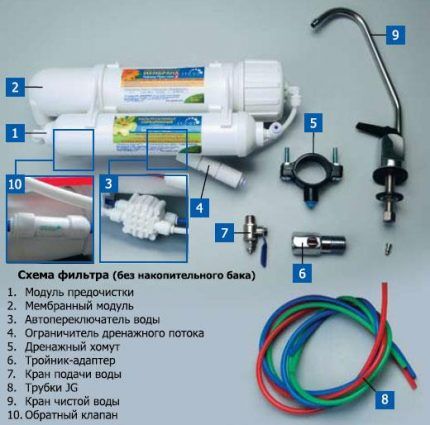
The number 2 is present when designating compact systems with reverse osmosis. If the marking contains the number 3, then the system has increased performance.
Recommendations for using filters
The service life, in addition to the quality of the system itself, is also influenced by its operating conditions and the timeliness of replacing individual elements. The main condition for long and uninterrupted operation of the system is optimal pressure. If it is within 4-6 atm, then the membrane works well, and the ratio between clean and dirty water is 1:2 or 1:3.
When the pressure decreases, the force to force water through the membrane is not enough and a larger volume of water goes into the sewer, and the life of the membrane itself decreases.
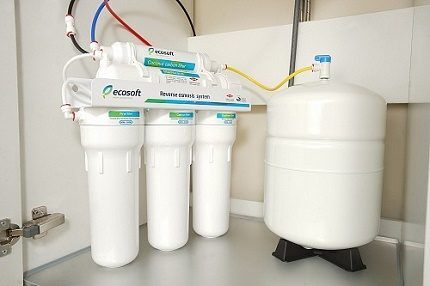
Other side effects also occur: pre-cleaning cartridges quickly become dirty, the storage tank is not completely filled, irrational water consumption increases, and housing filters become intensively silted.
Malfunctions in the reverse osmosis system can be recognized by the following signs:
- Constant gurgling of water, indicating that water is being discharged into the drain continuously.
- An increase in meter readings by 2-3 cubic meters per month from usual.
- Contamination of primary cleaning cartridges within 2-3 months.
- A one-time drain from a storage tank in a volume of less than 7 liters or a complete absence of water in it.
- No water flow through an open tap when the tank is completely filled.
- The appearance of scale in the kettle and the water tastes salty.
- Extraneous sounds in the form of clicking sounds when the pump is operating, indicating frequent switching on and off of the pump.
- The pump does not turn on.
- When the tank is completely full, the pump does not turn off and it gets very hot.
- Hot power supply when the pump does not turn on.
- The water supply is turned off, but the pump is running.
Improperly functioning filters create a negative opinion among consumers regarding certain good filter systems. And sometimes you can correct the situation by simply installing a booster pump if the pressure is below 3 atm.
Conclusions and useful video on the topic
To fully understand the specifics of reverse osmosis filters and study the ratings of manufacturers of water purification devices, we offer a selection of videos.
Video #1. Introduction to the operating principle of a double osmosis filter:
Video #2. Recommendations for choosing a filter for drinking water preparation:
Video #3. Instructions for those wishing to install reverse osmosis filters themselves:
It is impossible to single out one of all reverse osmosis systems and say that it is the best. Their parameters are determined by the throughput of the membrane and the volume of the tank. It is believed that for good water quality, 3 stages of purification are sufficient. And the choice depends on the individual needs of each person.
Would you like to share the subtleties of filter selection known only to you? installations in a reverse osmosis system? Do you have any recommendations for using a drinking water treatment system or have any questions? Please write comments.




I recently purchased an Aquaphor Morion reverse osmosis filter for my family. This model does not take up much space and is easy to use.We are satisfied with the quality of the water; this filter retains heavy metals, bacteria, harmful impurities, nitrates and salts. I think the quality of the filter itself is good, there have been no complaints so far. I haven’t changed the filters yet, but I think there shouldn’t be any problems with this, the instructions should tell you how to do this.
I consider the Zepter reverse osmosis filter to be more reliable and of higher quality. The design looks beautiful, the faucet is still working properly, there have not been the slightest complaints yet. It was easy to assemble and took me about 15 minutes. Although it is more expensive, it purifies water quite efficiently. We tried Aquaphor and didn’t like it. Zepter performed well, they even did a water analysis. The indicators pleased us. The water itself even tasted different than from the tap without purification. You can, of course, change the filter once every six months earlier, but, as they say, it’s everyone’s business. I recommend it, verified, so to speak, personally.